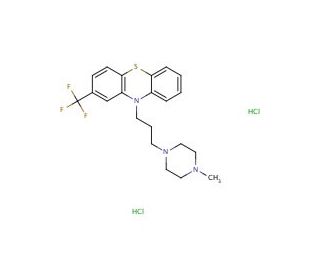

Trifluoperazine Dihydrochloride (CAS 440-17-5)
See product citations (9)
QUICK LINKS
Trifluoperazine Dihydrochloride is extensively utilized in research focusing on its role as a dopamine receptor antagonist. Studies frequently explore its effects on neurotransmitter systems, particularly dopamine pathways, which are integral to understanding various aspects of neurological function and behavior. Researchers use Trifluoperazine Dihydrochloride in experiments designed to elucidate the mechanisms of action in neurotransmission disruptions and their impact on neural circuits. This compound is also a subject of interest in studies related to stress response and neuroplasticity, where its influence on dopamine receptors may affect cellular adaptations. Additionally, Trifluoperazine Dihydrochloride is employed in research investigating its interaction with calcium signaling pathways, providing insights into its broader pharmacological impacts.
Trifluoperazine Dihydrochloride (CAS 440-17-5) References
- Calcium-induced quiescence of sperm motility in the bluegill (Lepomis macrochirus). | Zuccarelli, MD. and Ingermann, RL. 2007. J Exp Zool A Ecol Genet Physiol. 307: 590-9. PMID: 17724674
- Measurement of antioxidant activity with trifluoperazine dihydrochloride radical cation. | Asghar, MN. and Khan, IU. 2008. Braz J Med Biol Res. 41: 455-61. PMID: 18622491
- Ca2+-, phorbol ester-, and cAMP-stimulated enzyme secretion from permeabilized rat pancreatic acini. | Kimura, T., et al. 1986. Am J Physiol. 250: G698-708. PMID: 2422955
- Repurposing of antipsychotic trifluoperazine for treating brain metastasis, lung metastasis and bone metastasis of melanoma by disrupting autophagy flux. | Xia, Y., et al. 2021. Pharmacol Res. 163: 105295. PMID: 33176207
- Teratogenic effects of a tranquilizer, trifluoperazine dihydrochloride on the yellow-fever mosquito. | Quraishi, MS. 1967. J Econ Entomol. 60: 1650-5. PMID: 6081038
- Trifluoperazine inhibition of calmodulin-sensitive Ca2+ -ATPase and calmodulin insensitive (Na+ +K+)- and Mg2+ -ATPase activities of human and rat red blood cells. | Luthra, MG. 1982. Biochim Biophys Acta. 692: 271-7. PMID: 6128998
- Trifluoperazine and chlorpromazine antagonize alpha 1- but not alpha2- adrenergic effects. | Huerta-Bahena, J., et al. 1983. Mol Pharmacol. 23: 67-70. PMID: 6135146
- Interpretation of changes in apomorphine-induced stereotyped behaviour in rats receiving continuous administration of trifluorperazine for 15 months. | Rupniak, NM., et al. 1984. Neuropharmacology. 23: 893-8. PMID: 6148709
- Inhibition of histamine release from human basophils in vitro by calmodulin antagonists. | Marone, G., et al. 1983. Clin Immunol Immunopathol. 28: 334-40. PMID: 6192958
- Phenothiazine compounds inhibit in vitro growth of pathogenic free-living amoebae. | Schuster, FL. and Mandel, N. 1984. Antimicrob Agents Chemother. 25: 109-12. PMID: 6703673
- Dopamine receptor binding predicts clinical and pharmacological potencies of antischizophrenic drugs. | Creese, I., et al. 1996. J Neuropsychiatry Clin Neurosci. 8: 223-6. PMID: 9081563
Ordering Information
| Product Name | Catalog # | UNIT | Price | Qty | FAVORITES | |
Trifluoperazine Dihydrochloride, 1 g | sc-201498 | 1 g | $56.00 | |||
Trifluoperazine Dihydrochloride, 5 g | sc-201498A | 5 g | $99.00 |
